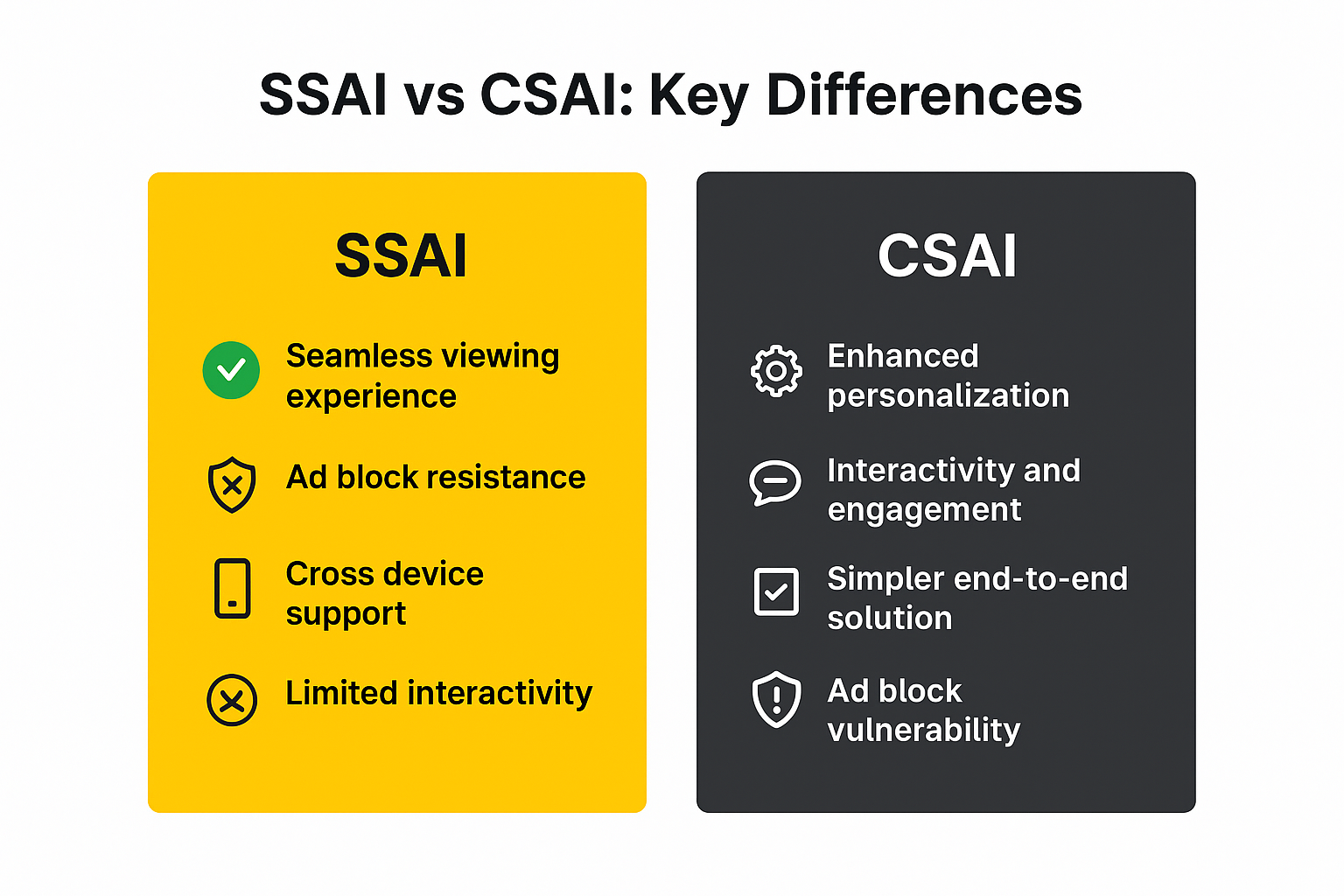CSAI vs SSAI – Which Ad Insertion Method is The Better Option For Your Business
In the dynamic landscape of digital broadcasting and streaming, the conversation around Client-Side Ad Insertion (CSAI) vs Server-Side Ad Insertion (SSAI) has become increasingly pivotal. As an industry leader in addressable TV, Castoola is at the forefront of this evolution, offering insights and solutions that resonate with monetization opportunities for TV operators, broadcasters, and OTT platforms.
In this article, we will explore what CSAI and SSAI are, how they work, and the different aspects that could affect the choices behind their implementation into video streaming ad workflows.
Understanding CSAI vs SSAI
Client-Side Ad Insertion (CSAI): Good for Personalizing
CSAI works on the client side, or the viewer’s device. It communicates with the ad server and loads ads separately from the content, enabling personalization and interaction. This approach allows dynamic ad insertion, where ads are tailored to the viewer’s profile in real time.
The benefits of CSAI include:
- Enhanced personalization: Ads can be targeted based on viewer and contextual data, increasing relevance and engagement.
- Interactivity and engagement: CSAI supports interactive ad formats, making ads more engaging and memorable.
- Simpler end-to-end solution: It allows faster deployment and monetization.
However, CSAI comes with its own set of challenges, such as increased potential for ad blocking, delays that cause buffering, and a viewing experience that is not always smooth.
Server-Side Ad Insertion (SSAI): Makes Viewing Seamless
SSAI, on the other hand, works by inserting ads into video content on the server side. This means that the ads are seamlessly integrated into the video stream without additional buffering or interruptions which improves the overall viewing experience. The integration of ads directly into the stream not only maintains the content’s flow but also makes it less susceptible to ad-blocking technologies.
Key advantages of SSAI are:
- Seamless viewing experience: Ads look like they are part of the content, eliminating buffering issues.
- Reduced ad blocking: Integrated ads are less prone to being blocked by ad-blocking software.
- Consistent experience across devices: SSAI ensures a uniform experience across various platforms and devices.
The primary limitation of SSAI lies in its technical complexity. This arises from several challenges that need to be addressed, including the transcoding of ad assets, ensuring ad markers for linear ad break replacement, and ad tracking.

CSAI vs SSAI: A Comparative Analysis for Effective Ad Insertion in Streaming
When it comes to video ad insertion, both CSAI and SSAI have their unique strengths and weaknesses that make them suitable for different use cases.
Now, the key question is: Which one should you choose? The answer depends on your specific requirements and preferences. This choice is not one-size-fits-all; it’s a strategic decision that hinges on what you prioritize in your advertising strategy.
If having greater control over the ad experience is important to you, CSAI may be the ideal choice. CSAI performs exceptionally well with niche and on-demand content, as it typically produces lower concurrency. Its simplicity unlocks new revenue stream quicker, and provides a wider range of personalization and interactivity, making CSAI an appealing option.
On the flip side, if you are seeking a scalable solution SSAI is the way to go. This method provides a more consistent viewing experience across various devices and platforms. With its resilience against ad blockers and impressive viewability, SSAI boasts an average completion rate of 98% on live TV (source: simplestream.com). Furthermore, SSAI reduces the processing requirements on the viewer’s device. In conclusion, the SSAI ad insertion method is great for linear and live streams, or VOD, as the ad is stitched directly to the stream.
Addressing Privacy Concerns
Navigating the complexities of data protection regulations like GDPR in Europe and CCPA in the USA is a critical challenge for publishers aiming to balance targeted advertising with user privacy. A notable concern in CSAI is the potential exposure of user IP addresses and cookies, potentially enabling third-party tracking.
SSAI presents a strategic response to these privacy challenges. By acting as an intermediate between the viewer and the advertiser, SSAI empowers publishers to manage data transmission more effectively. This approach not only complies with privacy regulations but also ensures a seamless viewing experience for viewers.
Leveraging the Power of Both CSAI and SSAI in Addressable TV
In the evolving world of Addressable TV, the decision to use either CSAI or SSAI isn’t a matter of choosing one over the other. Rather, it’s about strategically combining their strengths to create a more effective, hybrid and phased approach model. This involves utilizing SSAI for live streams and linear content to ensure a smooth and uninterrupted viewing experience.
Meanwhile, CSAI can be employed for on-demand content where a higher degree of personalization is desired. Integrating SSAI’s seamless in-stream capabilities with CSAI’s flexible out-stream advertising forms a comprehensive solution that meets diverse advertising needs without sacrificing viewer engagement.
Elevate your Addressable TV Ads with Castoola
At Castoola, we are dedicated to mastering the complexities of CSAI and SSAI technologies, guiding our clients towards making the best choices for their unique needs. Our goal? To make sure you maximize the monetization potential of your media, ensuring your viewers enjoy smooth streaming, while your ads hit the mark.
Find out how our solutions can help you and send us an email to request a demo.








